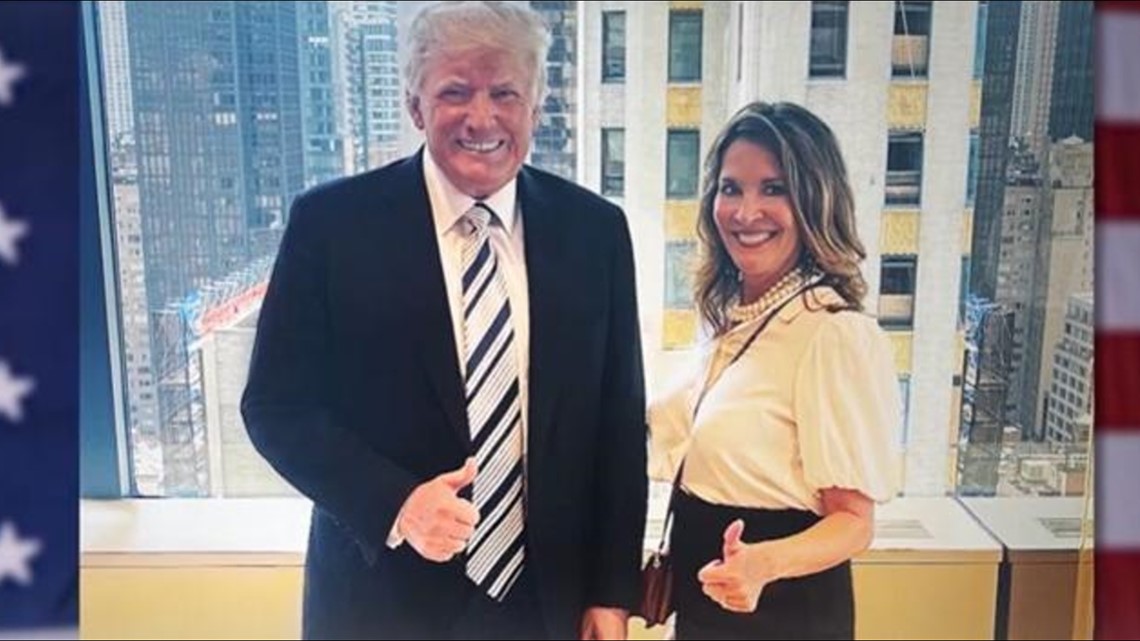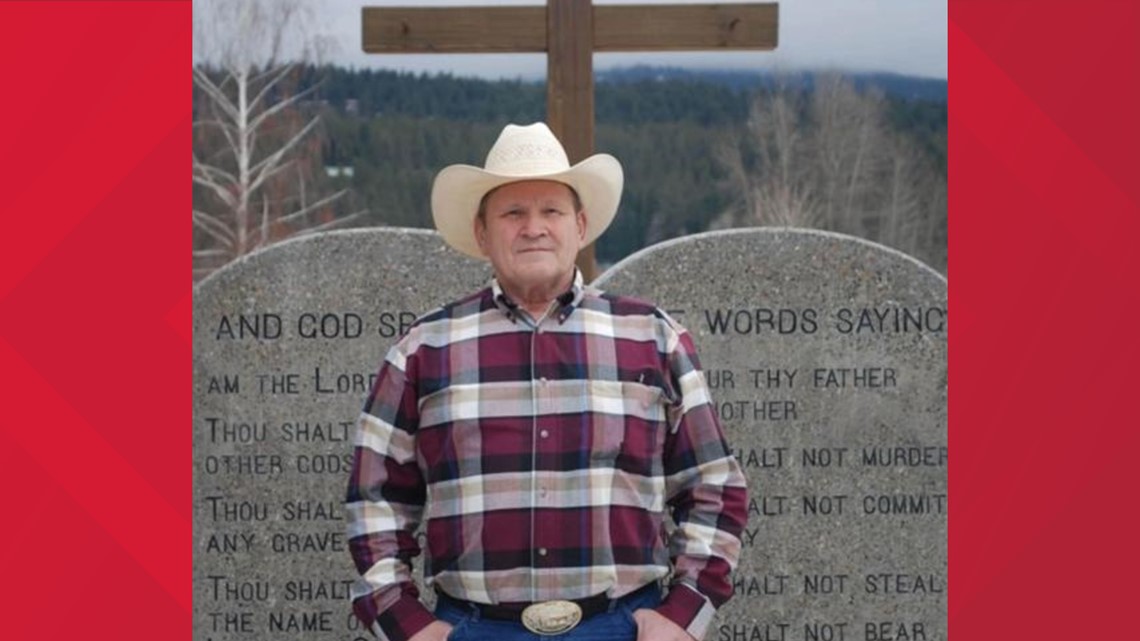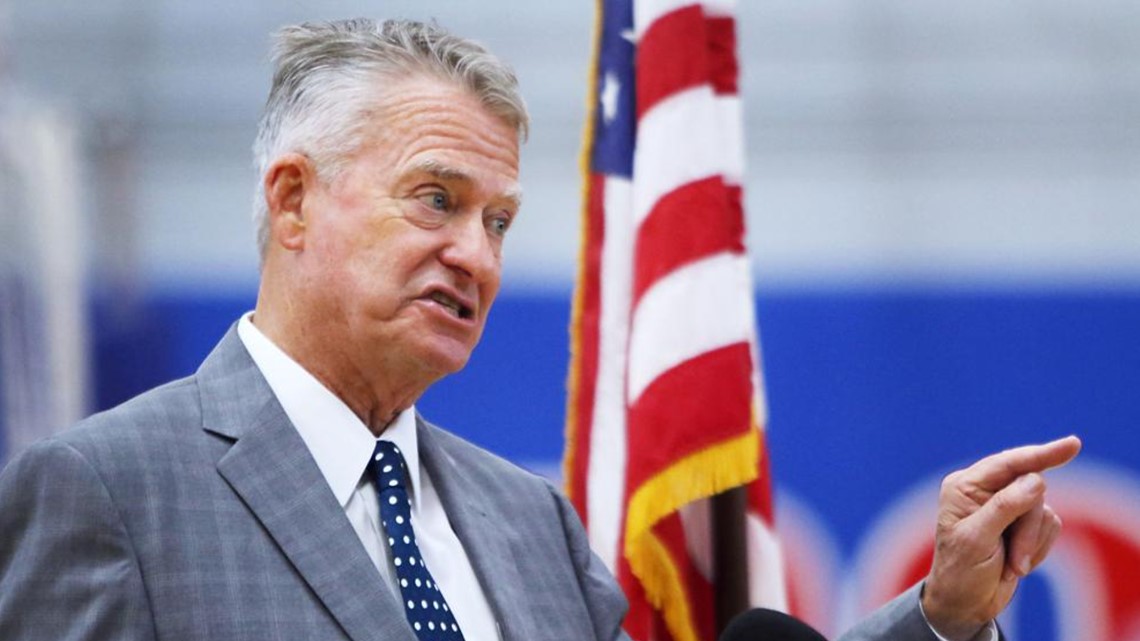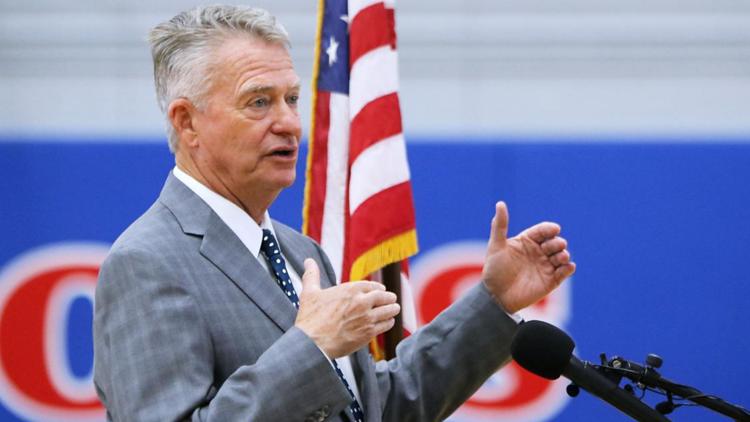BOISE, Idaho — This article originally appeared in the Idaho Press.
Idaho is facing a novel prospect in the GOP primary for governor this year: A sitting governor challenged by his lieutenant governor of the same party for the first time in state history, along with a slew of other candidates in an eight-way race.
Lt. Gov. Janice McGeachin has run a flashy but chaotic campaign against Gov. Brad Little, with other active GOP challengers including Eagle businessman Ed Humphreys, who’s been campaigning full-time for a year; and Bonner County Commissioner Steve Bradshaw.
Coming at a time when the state’s dominant political party is deeply divided, the situation has some parallels to 1966, the only time an incumbent Idaho governor was defeated in a primary election — but also distinct differences.
Back then, it was a two-way race in the primary when then-Sandpoint state Sen. Don Samuelson defeated three-term GOP Gov. Bob Smylie, in the wake of divisions within the Idaho GOP over popular but unsuccessful 1964 presidential nominee Barry Goldwater.
“Lately, the norm has been seven-way races, which is a very significant advantage for the incumbent, and an almost hopeless hill to climb for the one or two significant challengers that might otherwise make an aggressive run at success,” said David Leroy, former Idaho attorney general and lieutenant governor and the GOP nominee for governor in 1986.
The result, Leroy said, is “a virtual certainty at renomination.”
Political historian and author Marc Johnson, who was a top aide to longtime Democratic Gov. Cecil Andrus, noted the historical parallels in a recent article, writing, “Much like Brad Little now, Smylie barely acknowledged in 1966 that he had an opponent. He touted the economy on his watch and pretended to be above the bitter controversy roiling the Republican Party.”
GOP PRIMARIES INCREASINGLY CROWDED
Little himself was first nominated for governor in a seven-way primary in 2018, taking 37.3% of the vote. He went on to defeat Democrat Paulette Jordan in the general election with nearly 60% of the vote.
McGeachin gained her current office after being nominated in a five-way primary in which she tallied just 28.9% of the vote, then also took nearly 60% in the general election against Democrat Kristin Collum.


Johnson said, “The party, I think, is really divided. It’s going to be interesting to see if that sort of insurgent wing of the Republican Party in some way makes a breakthrough here beyond what they already have done, which is elect a lieutenant governor and elect a pretty substantial number of people to the Legislature.”
Little has ducked debates with his opponents, declaring his record in office – and particularly the state’s booming economy – “non-debatable.” His four years in office have seen ups and downs, with strong successes on his top three priorities – education funding, including boosting teacher pay and increasing funding for early reading programs; tax cuts; and reducing state regulations – but strong pushback from his own party’s lawmakers over his responses to the COVID-19 pandemic. Though Little never imposed a statewide mask mandate or vaccine requirements and backed off from state-level restrictions early in the pandemic to a local-control model, he was vilified by opponents on the right and spent an entire legislative session fighting attacks from lawmakers intent on curbing the governor’s emergency powers. That included vetoing two far-reaching bills with support from every living former Idaho governor.
His relationship with lawmakers improved this year, and he was able to push through much of his “Leading Idaho” agenda, including big investments in education, transportation, broadband, water and sewer infrastructure and more.
MCGEACHIN MAKES HEADLINES
McGeachin has repeatedly grabbed national headlines, but they’ve been mostly negative. She twice issued executive orders attempting to reverse Little’s policies while he was briefly out of state, only to have them immediately reversed. She’s currently working without salary after overrunning her relatively tiny office budget as lieutenant governor, and no longer has any staff. While she secured the endorsement of former President Donald Trump, her decision to address a white nationalist convention in Florida via video drew widespread condemnation back home.
Bradshaw, a second-term Bonner County commissioner and the full-time pastor of the Cocolalla Cowboy Church for the past 21 years, said, “She’s made some bad decisions, and I wish she hadn’t of – I liked her. Why she did the recording for the white nationalist group is beyond me, it’s like, what the heck were you thinking? … It’d be different if it was a major issue in Idaho, a major group here. But 10 states away, is like, you’ve got to stop and think what’s the cause and effects here, what’s the value?”


Bradshaw has dark suspicions about the state budget, questioning whether “a whole bunch of smoke and mirrors” created Idaho’s record budget surplus. His county sued the state unsuccessfully in federal court over the distribution of CARES Act aid funds, not only losing the lawsuit but also paying more than $187,000 in legal fees to a southern California law firm and losing out on an additional $2.1 million in aid.
Bradshaw, 67, said, “This is not a career move for me, I do not need a career. … It’s a job that’s got to get done and needs somebody with the experience, the tenacity and the backbone to push back against the state.”
He said, “Day 1, as soon as my hand comes down from swearing in, the first executive order will be ending the grocery tax. Next one will start the process of taking public lands back.”
However, neither of those could be done by executive order. “Taxation is tightly controlled by constitutional mandate and legislative action, exclusively,” Leroy said. Furthermore, “Neither the state government nor the federal government, which gave us lands at the creation of statehood in 1890, can take back the lands of the other by edict.”
HUMPHREYS CAMPAIGNING FULL-TIME
Humphreys, 31, quit his job as a financial adviser a year ago to campaign full-time for governor. He lists his top three issues as school choice, including routing tax dollars to private schools if that’s the parents’ choice; capping property taxes for as long as the owner owns the property, with only inflation adjustments; and abolishing the state’s individual income tax while keeping the corporate tax.
All three would face major constitutional, legal and financial obstacles, but Humphreys isn’t fazed by those. The Idaho Constitution, for example, forbids public funds from going to religious schools, and requires property taxes to be equal on like property — something that wouldn’t happen if one owner’s taxes were capped, but their newly arrived neighbor’s weren’t. “If all the attorneys determine that it’s got to be a constitutional amendment, then so be it,” Humphreys said.


Idaho’s individual income tax accounted for 49% of the state’s general fund revenues in fiscal year 2021, or $2.45 billion; with sales tax at 40%, corporate tax at just 7%, and all other sources at 4%.
“I actually estimate that in four to six years, the $2 billion loss of revenue from the income tax would actually be replaced by more revenues coming in, from, like, sales taxes and use taxes,” Humphreys said, though he’s not proposing those rates be increased.
“That’s magical thinking,” said Michael Ferguson, who was the state’s chief economist for 25 years under six governors. Calling the estimate “unrealistic,” Ferguson said, “I just don’t see how that would be remotely viable.”
Humphreys moved to Idaho in 2013 from western Colorado after working as a roughneck on oil drilling rigs; he’s since earned online bachelor’s and master’s degrees and worked as a financial planner for Edward Jones for five years. “I have a really unique background and perspective,” Humphreys said. “And I think that’s what’s missing from state government. … I never finished the 8th grade, and later went on to get a master’s in finance later in life. … I’ve lived on both sides of the tracks.”
He noted that his family came to the United States from the former Yugoslavia, and his paternal grandmother fled Nazi Germany. “We’re putting everything on the line because I’m just not going to live a repeat here in America of what my family fled from,” Humphreys said. “They wanted to be able to make decisions for themselves, and I’m concerned we’re losing that.”
BRADSHAW ‘TURNED IT OVER TO THE LORD’
Bradshaw said, “Ed Humphreys is a young guy, I like him – super nice guy, good, polished speaker, but has no experience in anything. … I don’t think he is what we need at this time. We don’t need somebody that’s coming to learn. We need somebody that’s coming to get the job done.”
Bradshaw cited his local government experience; he’s been a county commissioner for four years and is in his second term. Asked why he first decided to run for office, he said, “I just woke up in the middle of the night and it felt like the Lord was saying, ‘Run for commissioner.’”
“He said, ‘I will teach you everything you need to know.’ And that’s in the Book,” he said. “I just turned it over to the Lord and went forward and followed His direction.”
McGeachin, 59, followed a more conventional path to the governor’s race, serving in the Idaho Legislature for 10 years, including chairing the House Health and Welfare Committee and serving on the budget-writing Joint Finance-Appropriations Committee, before running for lieutenant governor in 2018, where she’s now served four years.
McGeachin, a business owner, owns automotive businesses with locations in Idaho Falls and Boise with her husband Jim, and an Irish pub and restaurant in Idaho Falls. The couple’s two adult children help manage the family businesses.
She holds a bachelor’s degree in accounting and finance from the University of Arizona, has lived in Idaho Falls for 40 years, is a former board member of the Development Workshop and the Mountain River Valley American Red Cross, and is Idaho’s first female lieutenant governor.
“I am running for governor because Idaho needs a proven, conservative leader who will not compromise her principles when the going gets tough,” McGeachin said in a statement to the Idaho Press. “We need a true conservative renaissance to Make Idaho Free Again!”
UNPRECEDENTED FOR TOP 2 TO CLASH
Her frequent clashes with Little since the two have served in office together — Idaho’s lieutenant governor and governor run separately, not as a ticket — have been unprecedented; even when the lieutenant governor and governor were from different parties, throughout Idaho history, they’ve generally collaborated.
Leroy recalled serving as the Republican lieutenant governor to then-Democratic Gov. John Evans. “On the first day we were together in the Capitol building, I walked down the hallway and we negotiated 12 or 13 things that I would do as lieutenant governor and as acting governor,” Leroy said. “One of those was to appoint Republican official vacancies when he was out of town. And he saved those for me, and I exercised that authority.”
“We also communicated when emergencies came up,” he said. “On one occasion, I called out the National Guard on a flooding emergency, in collaboration and communication with the governor. So during his four years, I was acting governor 254 days, without political flip-flops or embattlements.”
“It’s not only possible, it’s necessary,” Leroy said. “It’s a cheap headline, but a public angst to have conflict between those two offices over that authority.”
“The lieutenant governor has, I think, misplayed her opportunity by some all too aggressive and publicly offensive moves,” Leroy said, “and I say that as kindly as one can, using those words.”
“It’s one thing to sharply differ with the governor on COVID-related issues or anything else, and say so. It’s yet another to end up creating flip-flops of public policy which are counter-productive and potentially costly in terms of public opinion and even public dollars.”
The clashes between McGeachin and Little became so intense that the governor’s office adopted a new legal and constitutional interpretation rejecting the authority of the lieutenant governor to serve as acting governor unless the governor was functionally, as well as physically, out of state, meaning unable to be in touch remotely to carry out official duties. An Idaho attorney general’s opinion found that among states that had litigated that issue, results were evenly divided. The only way to settle the issue would be to take it to the Idaho Supreme Court.
Many expected McGeachin to do that, but Leroy said, laughing, “The budget wasn’t available.”
“Speaking of mistakes,” he said, “that’s a glaring one. … To mismanage one’s budget, large or small, is not endorsed under the Idaho Constitution.”
BUDGET SHORTFALL BECOMES ISSUE
McGeachin in April of 2021 formed a task force to “examine indoctrination in Idaho education and to protect our young people from the scourge of critical race theory, socialism, communism, and Marxism.” She solicited public comments and received thousands, but after she refused to release them in response to public records requests from multiple Idaho reporters, McGeachin lost a public records lawsuit filed by the Idaho Press Club. She was fined $750 for “bad faith” violations of the Idaho Public Records Act, and was ordered by the court to pay the club’s attorney fees of $28,974. The records showed the public comments submitted were overwhelmingly negative about the task force’s allegations and work.
McGeachin’s office budget this year is $183,100 in state general funds. She requested a supplemental appropriation, first asking for an additional $50,000 in state general funds, then lowering that to $28,974 to cover additional legal costs in her office this year, but lawmakers never acted on the request.
That contributed to her budget shortfall that this month brought her warnings from the state Division of Financial Management that in addition to eliminating staff, she would need to decide whether to forego her salary, halt vendor payments and pay her health insurance premiums. She responded April 14 by directing her salary to be withheld, and calling the process “a rather pointless formality.”
Idaho’s state budget, which is proposed by the governor, then set by the Legislature and signed into law by the governor, is more than $4.2 billion in state general funds and nearly $11.3 billion in total funds.
“That’s a problem,” Bradshaw asserted. “If you can’t handle a little number, what are you going to do with a big number?”
McGeachin lists her top three issues in her run for governor as protecting individual liberty; “defending our state sovereignty,” and upholding “traditional conservative values.”
“I want Idaho to be the state that best supports traditional family values, small businesses, and family farms as we push back against federal overreach and leftist ideology,” she said.
LITTLE: ‘JUST GETTING STARTED’
Little, 68, an Emmett native, is a third-generation rancher from a prominent Idaho ranching family who holds a bachelor's degree in agribusiness from the University of Idaho. He served four terms in the state Senate, rising to majority caucus chairman, and was appointed lieutenant governor in 2009, then twice reelected before winning the governorship.


“I am committed to continue working on behalf of all Idahoans to strengthen our economy, invest in education and protect our values so everyone, especially our children and grandchildren, will have the ability to build careers and raise their families here in Idaho,” Little said in a statement when he filed for reelection.
His oft-stated mantra since 2018 has been that everyone’s kids and grandkids should be able to stay in or return to Idaho and build lives here, something that’s prompted him to focus increasingly on the state’s affordable housing crisis. This year, he successfully persuaded lawmakers to approve $50 million in federal funds for the state’s first-ever gap financing program for affordable housing development. The Legislature had created a housing trust fund for that purpose three decades earlier, but it had never been funded.
Little said in a statement, “During my first term, together we achieved billions in historic tax relief, record investments in transportation, and continued our strong support for education in Idaho — and we are just getting started!”
The other four GOP candidates on the Nov. 17 ballot for governor have done little campaigning. Ashley Jackson of Preston has launched a website touting her as “America’s first pro-cannabis Republican governor” and urging, “Please join my grassroots movement — anything helps!” Cody Usabel of Meridian has a Facebook page on which he frequently rails against President Joe Biden.
Tom Luna, Idaho Republican Party chair, said when he attends meetings of state GOP chairs, “every state has a story, but when I stood up and shared with them that my incumbent lieutenant governor was running against the incumbent Republican governor, they all said, ‘OK, you win.’”
“Our position is always to remain neutral and to treat all candidates the same,” he said. “At the end of the day, a majority of Republicans will decide which candidate best represents their views, and then we’ll unite around that candidate who will become our nominee, and we’ll move heaven and earth to get them elected.”
This article originally appeared in the Idaho Press, read more on IdahoPress.com.
Watch more Idaho politics:
See all of our latest political coverage in our YouTube playlist:



